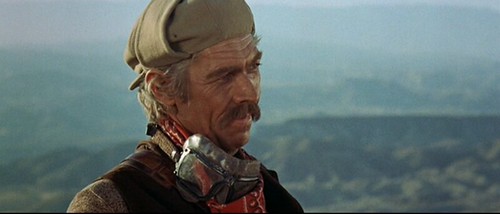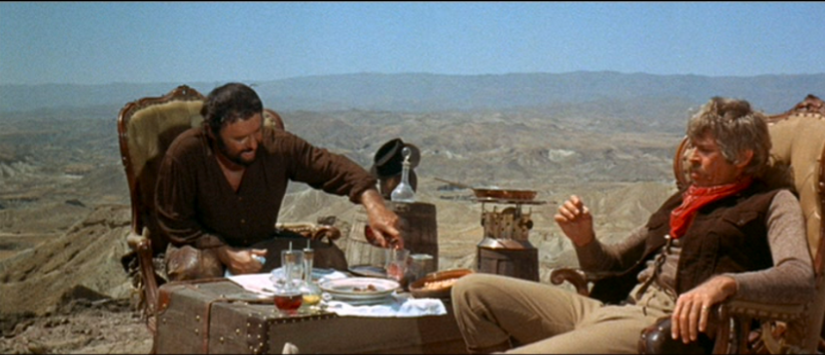“Duck You Sucker” or DYS, was Sergio Leone’ second movie in the “Once
Upon A Time...” series. The first one being the 1968 movie, “Once Upon A Time in the
West” which starred the legendary actors Henry Fonda, Charles Bronson, Jason
Robbards and Claudia Cardinale. Duck You Sucker was originally titled “Once Upon A
Time A Revolution” but the American studios decided against the title because
they thought the title was too “Leftist”. DYS was released in 1971 and it stars
James Coburn and Rod Steiger as the dual main leads. Many film critics and
Leone fans have regarded DYS as Leone’s first Zapata western, which is a
sub-genre of westerns that are set in the times Mexican revolution of the
1920s. Sergio Leone is known more for his “Dollar Trilogy” namely “A Fistful of
Dollars”, “For A Few Dollars More” and the epic “The Good The Bad and The Ugly”
and the “Once Upon A Time In The West” and this movie happens to be his lesser known film. The musical score in the movie was
provided by the famous music director and a class-mate of Leone since his early
school days, Ennio Morricone, who had also composed soundtracks for his earlier
films. For some reason, DYS is a hugely underrated film that does not enjoy the
popularity of Leone’ other films. Not that it is any inferior in any sense of
the word, compared to his other works, in fact it stands on its own and completely
alone.
The film begins with a poor Mexican peasant getting a ride in a luxurious
horse driven omnibus, passing through the dry and arid Mexican landscape. He is
ridiculed by the upper class bourgeoisie passengers, who mock him for being an uneducated,
uncultured, undiscerning fool and as one of the passengers says “unfortunate
brutes”. The whole stagecoach sequence is powerfully shot and acted. Leone through
his impeccable directorial style articulately depicts the relationship between
the feudal bourgeoisie and the clergy in relation to that of the poor and the
down-trodden masses and how they view them, sitting in comforts of their ivory
towers, as nothing more than animals fit for exploitation for their own satisfaction
of their greed and advancement of their wealth and property.
Juan Miranda (Rod Steiger) is a ruthless but a bumbling yet a likable bandit chief. He has one big dream, the only goal in his life and that is to
rob the Bank of Mesa Verde. On his way, he meets an Irish revolutionary on the
run, Sean Mallory (James Coburn) who is also a dynamite expert and is wanted by
the British government for his involvement in the activities of the Irish Republican
Army. Juan understands Mallory’ skills with dynamite and sees him as a valuable
asset to his group and his mission to rob the bank of Mesa Verde. After a
couple of runs and chases, the two eventually get together and accomplish a
successful raid in the bank. Unbeknownst to Juan, he released hundreds of the
political prisoners kept in the make shift jail in the Bank of Mesa Verde and
he has suddenly become the most famous leader of the revolution. Now whether he
wants it or not, he has been sucked into revolution and he has no choice
getting out of it much to his personal dismay.
The movie has many subtle themes of friendship, trust, loyalty and
faith. For the first time in a Leone film we see characters undergoing a change
in their innate personality. Juan undergoes transformation from being a greedy
and a ruthless bandit to a fighter participating in a revolution. The film does
not have heavy dialogues, no boring political commentary, no needless
sermonizing but only situations and how they have profound effect on us and how
they force us to think and act differently.
Leone, who grew up in Fascist Italy under the rule of Benito Mussolini,
was a sympathizer of the leftist cause, leaves no room to express his distaste
for those “pseudo-leftists” and “pseudo-revolutionaries”. In one scene in the
film, a character remarks “People who can read books tell people who cannot
read books, that time for change has come. They talk and talk, eat and eat and
what happens to the poor people? They are dead!”.
Also to note is the Sergio Leone' use of artistic impressions of “Surrealism”.
Sergio Leone was no doubt a product of the new wave movement of neorealism in
Italian cinema post WWII. Sergio Leone was also a great admirer of the works of
surrealist painters such as Giorgio Di Chirico and Salvador Dali and tried to incorporate
the surrealist art in his movies starting from “The Good The Bad And The Ugly”
to “Once Upon A Time In The West” and then again in “Duck You Sucker”. The film
has all the trademarks of Sergio Leone, the extreme close ups of face and the
eyes of the actors, use of arid, desolate landscapes, use of non-actors,
minimalist dialogues, sudden gun fire etc. Of course, no mention of a Leone
film is complete without the mention of film’s soundtrack and its composer
Ennio Morricone. “Gui La Testa”, “Invenzione Per John” and “March Of The
Beggars” are some of the best tracks ever composed for a film. “Invenzione Per
John” is just a superb composition that would take a listener to a completely
different plane of consciousness and the composition is the very heart of
movie. Perhaps it is “Invenzione Per John” that makes the movie more than ever likable It is hypnotic, it is soothing and it is calming and yet at the same
time it arouses your creative instincts.
In all Duck You Sucker is a movie that is paced enough from the beginning.
It takes its own time for characters and situations to develop and though it
may slow down a bit in intervals but that is hardly noticeable. This is one
Leone movie that needs to be seen by one and all along with his other well-known
movies.
All Images Courtesy: Google.






